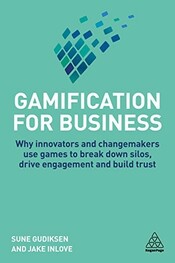
Gamification for Business - Book Summary
Why Innovators and Changemakers Use Games to Break Down Silos, Drive Engagement and Build Trust
Release Date: April 2, 2024
Book Author: Sune Gudiksen, Jake Inlove
Categories: Creativity, Management & Leadership, Corporate Culture
Release Date: April 2, 2024
Book Author: Sune Gudiksen, Jake Inlove
Categories: Creativity, Management & Leadership, Corporate Culture
In this episode of 20 Minute Books, we dive into "Gamification for Business" by Sune Gudiksen and Jake Inlove, published in 2018. This insightful book navigates the transformative power of games in the business realm. The authors, leveraging their profound expertise in game design and innovation, unveil how gamification can effectively tackle organizational hurdles, enhance teamwork, uplift employee motivation, and forge novel avenues for advancement and change.
Sune Gudiksen pairs his role as an associate professor of design and innovation management at Design School Kolding in Denmark with the leadership of the Biz Games community platform, a hub for game-based learning in business. Jake Inlove, holding a master's degree in Education Science from the University of Aarhus, combines his skills as a game designer with innovation consulting to challenge and reshape traditional approaches to business development. Their joint venture, Gamebridges, seeks to pioneer the integration of game mechanics into business strategies, facilitating organizational innovation and engagement.
"Gamification for Business" is an indispensable read for businesses poised to resolve organizational dilemmas and fuel innovation, educational institutions aiming to invigorate their teaching methods, and individuals in search of a creative spark to ignite new ideas. Join us as we explore the game-changing strategies detailed by Gudiksen and Inlove, offering a comprehensive overview of how gamification can be a catalyst for change in the business landscape.
Unlock the Power of Play: How Gamification Transforms Business Challenges into Opportunities
Imagine hitting a rough patch on your business journey, where teamwork starts to crumble, motivation dwindles, and fresh ideas seem as elusive as ever. It's a scenario many organizations face at one point or another. But what if there was a way to reignite that spark within your team using something as universal and engaging as games? Welcome to the world of gamification — the art of infusing game principles into everyday business challenges to drive innovation, collaboration, and learning.
Gamification is not just about making work fun. It goes deeper, leveraging the interactive, immersive, and inclusive aspects of games to address and overcome key organizational hurdles. Whether it's the lack of clear business objectives, ineffective meetings, or a gap in open communication, gamification offers a creative solution that can transform these challenges into opportunities for growth and learning.
This narrative will guide you through the adventurous path of using games to breathe life back into your business operations. You'll discover how games can catalyze honest, constructive dialogues among team members, unlock a treasure trove of innovative ideas, and carve new paths for breakthroughs and growth. Throughout this journey, you'll gain insights into:
- The holistic benefits that games bring to the business landscape, enriching both the organizational culture and individual experiences.
- The equalizing effect of games in a business context, which fosters teamwork and collaboration by placing everyone on a level playing field.
- Strategies that managers can adopt from the gaming world to enhance their leadership skills and cultivate a more dynamic and responsive team environment.
Embrace the transformative power of gamification and learn how it can help you navigate through common business challenges with a renewed sense of purpose, engagement, and creativity. With practical examples and insights, this journey will show you how turning to the world of games can open up new horizons for your business.
When Play Becomes the Ultimate Teacher: Harnessing the Power of Games in Business
Remember those childhood days filled with endless imagination and games that transported you to new worlds? Whether it was constructing epic Lego castles, embarking on imaginary adventures, or playing hide-and-seek amidst the trees, those moments were more than just play. They were your first classroom — a space where you learned through the joy of doing, where each game was a lesson wrapped in fun.
This concept, known as constructionism, was brought to light by MIT professor Seymour Papert and entrepreneur Idit Harel. Their research revealed that engaging our senses — like touching and seeing — simultaneously, enhances our ability to absorb and understand information. Games epitomize this learning model by offering tangible objects and scenarios that encourage us to think creatively and learn through action.
Translate this idea into the business world, and you unlock a realm of possibilities where games become a tool for skill development and innovation exploration. Beyond skills, games have a unique power to democratize the workplace, breaking down traditional hierarchies to create an even playing field. Picture the dynamics of a soccer team during a match; what matters on the field isn't your job title or background but your skill and team spirit.
Katie Salen and Eric Zimmerman, champions of gamification, eloquently term this environment the "magic circle." In this space, the conventional social norms are paused, inviting participants to step into new roles, challenge the status quo, and imagine alternative ways of interacting and achieving goals.
Despite the clear benefits, many businesses remain skeptical, adhering to the misconception that play and productivity are mutually exclusive. This mindset leads to dry, uninspired meetings and training sessions, missing out on the vibrant opportunities that gamified experiences offer.
However, as we'll explore, integrating games into the business environment isn’t just about injecting fun into the mundane. It's a strategic approach to solving organizational challenges, fostering teamwork, and unlocking a treasure trove of creative solutions. Join us as we delve into how games can revolutionize learning and collaboration in the business world, proving that sometimes, the best way forward is to play your way through.
Bringing Forth Unity and Motivation: How the Align Game Reinvents Corporate Identity
Imagine you're at the helm of a burgeoning tech empire that's quickly sprawling across Europe. Your products are flying off the shelves, and your company is the talk of the tech world. But just as you're admiring the view from the summit, you realize there are storms brewing on the horizon. The challenges of managing a diverse team across borders, keeping pace with the competition, and maintaining a motivated workforce threaten to derail your journey.
In such times, it's crucial to ensure that your team remains united, driven, and aligned with the spirit that set your venture in motion. But how do you make sure every member of your fast-growing team stays connected to your original blueprint, especially when everyone is scattered across the continent?
The answer lies in cultivating a strong corporate identity rooted in shared values—and what better way to achieve this than through play? Enter Align, a transformative online game tailored to binding teams around common core values.
Align is more than just a game. It's a journey that guides teams to navigate their company's ethos by engaging with real-life scenarios through the lens of designated core values. Designed for groups of four to eight players, the game unfolds around a digital sphere where participants are thrown into various business situations via challenge, event, dilemma, or chance cards. Each card presents a unique scenario, plunging players into decision-making processes that reveal deeper insights into their alignment with the company's foundational beliefs.
The true magic of Align lies in its scoring system, which doesn't merely tally points based on individual prowess. Instead, it assesses responses for their adherence to the game's cardinal values of courage, passion, and customer focus, as well as their impact on critical organizational outcomes like employee satisfaction, customer happiness, and sales performance.
This engaging foray into value-based decision-making fosters a collaborative environment where success is measured by the collective ability to embody and advance the company's guiding principles. Through this collective gameplay, team members gain a profound understanding of how living these values impacts their daily work and contributes to the organization's overarching goals.
With Align, businesses can transform the abstract notion of "company values" into tangible actions and decisions, ensuring every team member is not just a cog in the machine but a vital keeper of the company's identity. By integrating this game into their value-building strategies, leaders can fortify their teams against the pressures of growth and competition, creating a resilient, unified front that's prepared to tackle the challenges and opportunities that lie ahead.
Boosting Collaboration and Communication: The Strategic Play of LinkXs
In the modern workplace, from buzzing startups to established corporations, the strength of a team's collaboration can often be the linchpin of success. Recognizing the importance of teamwork, it's no surprise that game-based strategies are increasingly sought after to enhance cohesion and collaborative spirit among team members. Among these innovative approaches, one game stands out for its unique ability to foster teamwork and unlock collaborative potential: LinkXs.
Designed for eight to twelve participants, LinkXs cleverly simulates the challenges and necessities of working in a collective environment. Players are divided into smaller groups, each tasked with a specific objective. However, the twist lies in the distribution of information. No single group has all the pieces of the puzzle; instead, knowledge is fragmented and spread across the teams. This setup necessitates negotiation and sharing between groups, making collaboration not just beneficial but essential for success.
Through its engaging format, LinkXs serves as a practical laboratory for exploring and enhancing collaborative behaviors. Participants emerge with valuable lessons in productivity optimization, conflict resolution, and the harmonization of individual ambitions with collective goals. All these outcomes trace back to a fundamental skill crucial in any teamwork scenario: effective communication.
In addition to LinkXs, games like Sudden Survey, crafted by the distinguished Indian learning expert Sivasailam Thiagarajan, shine a spotlight on communication skills within a team context. Sudden Survey is a high-paced game that aligns perfectly with company events or training programs aimed at fostering open dialogue and rapport among colleagues. Teams of three to five are challenged to explore a topic deeply relevant to their work through a meticulous yet exhilarating process of data collection, analysis, and presentation — all within a strikingly short time frame.
Resembling a business-oriented twist on speed dating, Sudden Survey propels players to interact intensively, engaging in rapid-fire discussions, questioning, and listening. This not only enhances networking and peer knowledge but also polishes participants' abilities to inquire thoughtfully and respond effectively.
Together, LinkXs and Sudden Survey represent potent tools in the arsenal of business games designed to enrich the fabric of teamwork within organizations. By integrating these games into the corporate development toolkit, businesses can significantly improve team performance, foster a culture of collaboration, and refine the essential art of communication among team members.
Turning Dull Meetings into Dynamic Workshops with Play
We’ve all been there — trapped in the dreaded "blah blah blah" meeting, where words float in the air but nothing truly lands. It's the kind of meeting where the excitement of brainstorming and strategizing is replaced by the monotony of one-sided presentations. Attendees nod in semi-agreement, their thoughts wandering, their voices silent. The lively exchange of ideas is conspicuously absent, and the room is charged with the energy of missed opportunities rather than the spark of engagement.
Dan Roam, in his critique of these uninspired gatherings, points out a crucial missing piece: action. Words, while powerful, often fall short in capturing the full spectrum of a problem or marshaling a team towards a solution. This is where the innovative concept of the Meeting Design Game comes into play — literally. The game introduces an element of playfulness into the otherwise stale atmosphere of planning meetings, making them more interactive, engaging, and ultimately, effective.
Designed for solitary strategists or collaborative teams, the game revolves around a set of design element cards that address various aspects crucial to the meeting's success. These elements range from objectives and content to participant involvement and physical setup, among others. The beauty of these cards lies in their ability to visually prioritize meeting components, steering the planning process into a more focused and participatory direction.
Here’s how it unfolds: the cards are spread out, inviting players to sift through and sequence them according to urgency. This simple act of ordering and reordering not only clarifies priorities but also highlights areas ripe for innovation. Participants then gravitate towards cards that spark ideas, physically moving them closer as a sign of commitment to explore those aspects further.
This tactile interaction with the planning process demystifies what often seems like a daunting task. By treating meeting design as a collaborative game, it unlocks creativity and ensures all voices are heard. Each card that moves closer to a participant symbolizes a pledge to contribute, making passive attendance a thing of the past.
The culmination of this game is a visually crafted action plan that delineates the key focal points. This roadmap not only ensures clarity and direction but also guarantees that the meeting will be an engaging session where everyone is invested and interactive.
By transforming the mundane task of meeting planning into an engaging, game-like experience, the Meeting Design Game bridges the gap between mere talking and actionable strategy. It turns potential "blah blah blah" meetings into dynamic, productive workshops where ideas aren’t just shared — they're created.
Mastering the Art of Business Growth with the Business Branching Game
In the dynamic theater of modern business, maintaining the momentum of existing projects while also venturing into new territories can often feel like walking a tightrope. The challenge of juggling ongoing operations with the pursuit of fresh, innovative ventures is a delicate balancing act that many companies struggle with.
Rita McGrath, a luminary in the realm of business strategy, puts forth a compelling analogy to describe this conundrum. She likens a company's portfolio to a tree with multiple branches, where long-term competitive advantages and quick wins represent different limbs. As some branches (old projects) mature and others (new opportunities) start to sprout, the critical task becomes how to adeptly redistribute resources across these branches to nurture growth without letting the tree toppel.
Visualize this scenario as akin to relocating from one home to another. The transition doesn't mean immediate closure for the old house; instead, it remains active as essentials are gradually transferred to the new dwelling. This shift uncovers items of enduring value that merit preservation and others that are ripe for discarding.
This metaphor encapsulates the essence of strategic agility required by businesses aiming for sustained profitability amidst ever-shifting market landscapes. The question then arises: How can organizations effectively cultivate such a dynamic balance between the old and the new?
The solution is elegantly presented through the Business Branching game, a strategic exercise underpinned by McGrath's value cycle theory. This theory, embodied in the game's concept of upstream flow, outlines a lifecycle for business branches encompassing five stages: launch, ramp-up, exploit, reconfigure, and disengage.
The game sets forth a straightforward yet profound objective: to inaugurate new business branches before the vitality of the old ones withers away. Failure to achieve this equilibrium risks the dire consequences of financial insolvency.
Players are thrust into scenarios where they must devise tangible strategies to propel a branch from one lifecycle stage to another — such as evolving a nascent venture into the ramp-up phase through an innovative sales strategy. Equally, they must navigate transitions from aging branches to burgeoning opportunities, all the while judiciously allocating resources to match each phase's demands.
The Business Branching game offers a vivid, interactive tableau for companies to hone their strategic finesse in balancing the nurture of existing operations with the exploration of novel ventures. It emphasizes the perils of overextending into too many new initiatives without the backbone of adequate resources and skills, serving as a pragmatic rehearsal for the intricate ballet of business growth and innovation.
Revitalizing Creativity with "Innovate or Dinosaur"
Stuck in the mud of conventional thinking? Meet "Innovate or Dinosaur," a game that might seem peculiar in name but is a beacon of hope for organizations thirsting for a drought of fresh ideas. The premise is straightforward yet profound: in an era where innovation is not just valued but vital, can your team adapt, or will it become a relic of the past, much like the dinosaurs?
The crux of this innovative dilemma lies in our neurological wiring, as highlighted by neuroscientist Donald Hebb. Our brains have a tendency to form fixed patterns of thinking — trodden paths in a vast forest of possibilities. This means we often unconsciously dismiss ideas that don't fit our preconceived notions. However, the brain's plasticity is our hidden ace — with the right stimuli, we can reforge these pathways, broadening our horizon of thought.
This is where "Innovate or Dinosaur" swings into action, divided into two engaging segments. The "Explore" board kicks things off, inviting players to pinpoint and dissect their organization's challenges. With the role of dice guiding their fate, participants draw cards that spur unconventional ideas to navigate these issues.
Transitioning to the "Evolve" board marks the game's second phase, sharpening the focus on implementing these fledgling concepts, assessing the effort involved, and sculpting them into viable actions. The game is a practical embodiment of Professor Eric J. Romero's advice to cast away outdated, "dinosaur" mindsets in favor of agile, creative thinking — a prerequisite for thriving in the competitive jungle of modern business.
Consider the transformative journey of an international property management firm, ensnared in the labyrinth of traditional ideation methods. Despite numerous brainstorming sessions, the path to innovative solutions remained elusive, and the quest for optimization seemed futile. Enter "Innovate or Dinosaur," which not only unlocked a treasury of creative ideas but also rejuvenated the team's spirit and operational efficiency. It was a revelation for the Director of Operations, who witnessed the rapid metamorphosis of his team from skeptics to pioneers of innovation.
"Innovate or Dinosaur" isn't just a game; it's a workshop for the mind that crystallizes the essence of transforming ideas into reality. It nurtures the innovative muscle within employees, shielding them from regressing into the abyss of obsolete thinking. With each roll of the dice and each card played, it challenges participants to leap beyond their cognitive boundaries and embrace the evolutionary spirit of innovation.
Level Up Your Leadership with Game-Based Learning
Navigating the complexities of management is akin to steering a ship through stormy seas. It's a role filled with challenges, from mediating conflicts to making tough decisions that may not always win popular votes. Yet, the core of effective leadership lies in the continual pursuit of self-improvement and the willingness to embrace innovative strategies for guiding teams through change. In this landscape of leadership development, games emerge as a powerful tool, offering immersive learning experiences that mirror real-life dynamics.
"Wallbreakers" stands out as a prime example of this innovative approach to leadership development. It is meticulously designed to encapsulate the essence of driving positive, lasting change within an organization. The game plunges participants into a fictional yet deeply relatable scenario: a large IT services corporation acquiring a smaller counterpart. Teams, comprising three to six members, are thrust into a simulation that unfolds across three pivotal stages – start-up, implementation, and anchoring. Along this journey, participants must navigate through the turbulent waters of change management, balancing a myriad of factors such as the intensity of change, resource allocation, and employee individualism.
The gameboard serves as a metaphorical playing field, with each team represented by a model bus populated with pawns that symbolize different employee personalities. The crux of the game lies in the decision-making process surrounding the pace of change, with players selecting from four "gear" cards that determine their approach. As teams wrestle with the dual challenges of driving change and maintaining the equilibrium of daily operations, they confront the stark realities of individual resistance and the consequences it bears on collective progress.
One of the most thought-provoking aspects of "Wallbreakers" is its treatment of resistance. Teams must make critical decisions about employees who are not in tune with the change, symbolically "kicking them off the bus" – a powerful analogy for the organizational need to move beyond those who impede progress. While seemingly harsh, this element of the game underscores the importance of adaptability and the costs of stagnation, both at an individual and organizational level.
Through this interactive experience, "Wallbreakers" not only sharpens participants' understanding of change management but also cultivates empathy towards varying employee perspectives. Players gain firsthand insights into the nuanced art of leading diverse personalities through change, equipping them with practical strategies that transcend the game and apply directly to real-world leadership challenges.
In essence, "Wallbreakers" exemplifies how game-based learning tools can revolutionize leadership development, turning abstract concepts into tangible, actionable skills. By stepping into the shoes of a change leader within the safe confines of a game, managers are better prepared to inspire, navigate, and implement change effectively in the dynamic reality of business.
Game On: The Transformative Power of Play in Business
Contrary to traditional perceptions that relegate games to the realm of leisure and distraction, a wave of insight has revealed the profound impact of playfulness on learning and innovation within the corporate world. Far from being merely a source of amusement, games emerge as potent catalysts for professional growth, strategic thinking, and organizational transformation.
When thoughtfully integrated into business practices, games provide a unique platform for employees to step into new roles, fostering a culture of empathy, collaboration, and resilience. This dynamic environment encourages individuals to break free from entrenched patterns of thought, illuminating uncharted pathways to solve complex problems and generate groundbreaking ideas.
More than mere entertainment, games serve as a key to unlocking the hidden creative potential within organizations. By embracing the principles of play, businesses can not only enhance their problem-solving capabilities but also cultivate a workspace that thrives on innovation, adaptability, and shared vision.
In essence, the message is clear — adopting a gameful approach is not a departure from serious business objectives; rather, it is a strategic embrace of an untapped resource that holds the promise of driving meaningful change, fostering a spirit of unity, and elevating organizations to new heights of achievement.





